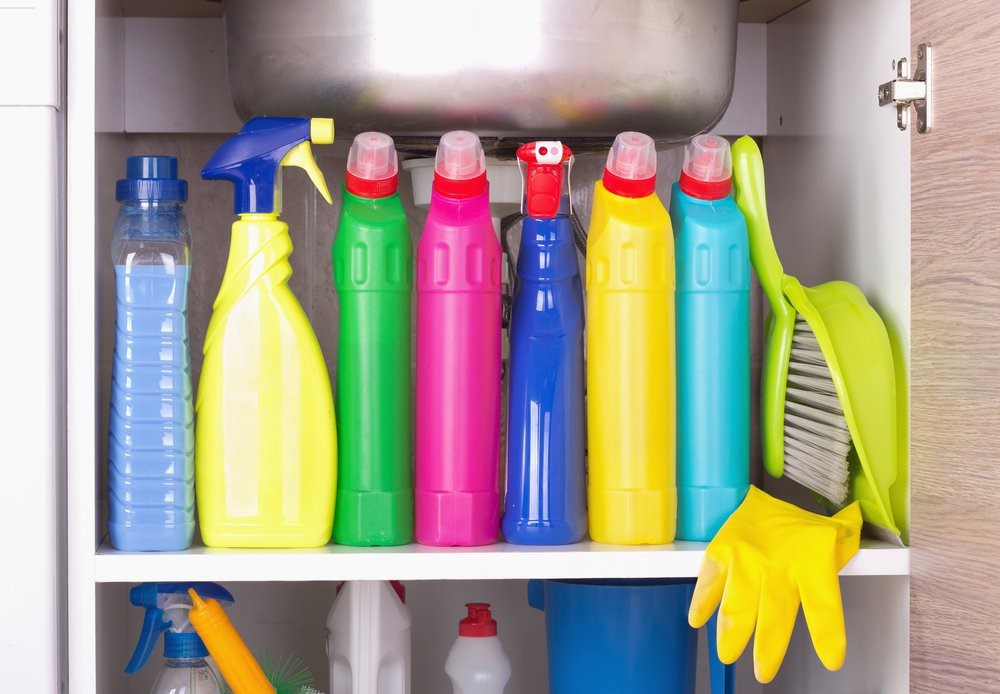Most folks think that chemical hazards are strictly limited to manufacturing or other industrial sites. The fact that there are potential chemical hazards in the safe confines of their homes often comes as a surprise.
A surprising number of residential fires are caused by the spontaneous combustion of stain application materials. When an oil-based stain is applied to furniture or flooring, the oils react with the oxygen in the air to form very large polymer chains. The process of the liquid stain turning to solid barrier is called curing (it is not drying via evaporation) and the reaction is oxidation. This reaction generates heat. On the floor or chair, the heat dissipates into the room without an issue. That same oxidation reaction is occurring on the brush, towel, sponge, or rag that was used to apply the stain. If those materials are piled in a corner or in a trash can, the heat cannot dissipate. If there is enough product present, enough heat can be generated to ignite the paper or fabric without a spark being needed.
To prevent spontaneous combustion from happening after your next DIY project, you can choose a stain that is not oil-based. If you use an oil-based product, properly dispose of the application materials. Either hang them up or lay them flat, individually, until they feel dry to the touch. You can also place them in a sealable metal container filled with water and a detergent. Never toss stain-soaked materials into a trash can or laundry hamper without first treating them with one of these methods.
Cleaning products can be powerful tools—but they can also create deadly reactions when combined. Below is a list of some common products with some bad actor by-products:
- Bleach + Ammonia
- Found in: Bleach cleaners + glass or window cleaners, urine, or some degreasers.
- Produces: Chloramine gas, which can cause coughing, shortness of breath, chest pain, and even pneumonia.
- Bleach + Vinegar
- Found in: Bleach + any acidic cleaner like vinegar or lemon juice.
- Produces: Chlorine gas, which is highly toxic and can cause burning eyes, throat irritation, breathing problems, and even death in high concentrations.
- Bleach + Rubbing Alcohol (Isopropyl Alcohol)
- Found in: Bleach + disinfectants or sanitizers.
- Produces: Chloroform and hydrochloric acid.
- Hazards: Chloroform can cause dizziness, nausea, loss of consciousness, and organ damage.
- Hydrogen Peroxide + Vinegar
- Found in: DIY cleaners using both products.
- Produces: Peracetic acid, a corrosive substance.
- Hazards: Can cause eye, skin, and respiratory irritation; can also damage surfaces.
- Drain Cleaner + Drain Cleaner
- Found in: Using two different types of drain cleaners back-to-back.
- Produces: Potentially explosive or toxic reactions due to differing chemical bases (e.g., acid vs. base).
- Hazards: Can cause burns, release dangerous gases, or even lead to explosions.
- Baking Soda + Vinegar
- Often used in: DIY cleaning solutions.
- Produces: Carbon dioxide (CO₂) and water.
- Hazards: Generally safe in small amounts, but in sealed containers, it can build up pressure and explode.
 It’s not like people purposefully combine these items like some sort of mad scientist. More often they use one product immediately after the other, without rinsing. Think of a “Well, if that didn’t work, I’ll try this,” type situation. So to prevent any unwanted chem labs in your house, make sure to read the labels of the products being used, rinse with water, if possible, and ventilate the work area well.
It’s not like people purposefully combine these items like some sort of mad scientist. More often they use one product immediately after the other, without rinsing. Think of a “Well, if that didn’t work, I’ll try this,” type situation. So to prevent any unwanted chem labs in your house, make sure to read the labels of the products being used, rinse with water, if possible, and ventilate the work area well.
This last one is a more recent phenomenon. Dry ice can now be purchased at many grocery stores in 1 or 2 pound packages. It is used to keep coolers cold longer or for fog effects for parties, etc. Dry ice is solid carbon dioxide, CO₂. It’s called dry ice because it doesn’t melt into a liquid. In fact, at -109 °F solid CO₂ goes straight to the vapor phase, which is known as sublimation (instead of evaporation, liquid to vapor).
As soon as the packages are removed from the freezer, the CO₂ begins subliming. The packages are designed with small holes to prevent them from bursting open from pressure buildup. This means the CO₂ is evolving from the package from the minute you leave the store until it is all transformed to vapor. If the vehicle or storage area is not ventilated, CO₂ gas can build up and displace oxygen. Because CO₂ is colorless and odorless, you may not notice the danger until symptoms like dizziness, confusion, or shortness of breath set in. So, always ventilate the area when using dry ice.
Home should be a place of comfort and safety, but hidden hazards can turn everyday materials into serious threats. By understanding the science behind spontaneous combustion, chemical reactions, and gas exposure, you can protect your home and family. A little awareness and precaution can go a long way in keeping your household safe.
As President of The Warren Group, Jennifer Morningstar, PE, CFEI, holds a Bachelor of Science Degree in Chemical Engineering from Virginia Polytechnic Institute and State University as well as a Master of Business Administration from the University of South Carolina. She is a licensed professional engineer in several states and a NAFI Certified Fire and Explosion Investigator. Jennifer has over 20 years of chemical engineering experience. Throughout her engineering career, Jennifer has conducted forensic investigations involving chemical release/exposure, OSHA process safety management, industrial accident investigation, fires & explosions, and equipment failures. Jennifer is a member of the National Association of Fire Investigators (NAFI), the South Carolina chapter of the International Association of Arson Investigators (SCIAAI), and the American Institute of Chemical Engineers (AIChE).






